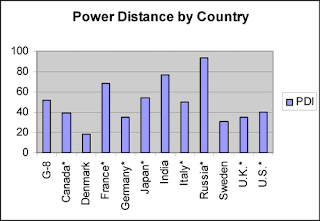
In his recent book, Outliers, Malcolm Gladwell writes about the role that “Power Distance” has played in a whole series of air disasters. Basically, the real problem in each case was not equipment failure, but communication failure - usually the inability of subordinates (such as the first officer) to tell the Captain clearly that he was screwing up.
Power Distance is a concept developed by Geert Hofstede as a result of years of research into management relationships around the world. It measures the extent to which less powerful managers feel they can challenge and confront more senior managers.
At one extreme are highly consensual societies, such as the Nordic countries, Germany, Austria and Switzerland, the Netherlands, Israel, the USA, Britain and Ireland, Australia and New Zealand. In these countries it’s expected that managers should and do speak up clearly to their superiors when there’s a problem (or an opportunity).
In the mid-range are many central and southern European countries (including France and Belgium, Italy, Spain and Portugal, the Czech Republic and Hungary), plus several in South-East Asia (Thailand, Hong Kong, Taiwan). In these countries a manager may think twice before challenging.
Up towards the autocratic end are China, India, Russia, Singapore, Korea and the Philippines, many of the Islamic countries (Saudi Arabia, UAE, Egypt, Iraq, Indonesia, with Malaysia at the very top of the list), and several in Latin America (Mexico, Brazil among them). In these cultures a manager often feels best advised to keep his/her mouth firmly shut rather than rock the boat.
Of course, Power Distance has a profound influence on innovation. For example, if a senior manager in a country with a high score pours cold water over a new idea, it’s far more likely to be fatally damaged. This makes the development of breakthrough new products, new strategies, new ways of working far trickier. And techniques like open brainstorming, which can work so well in an open climate, are nowhere near so useful or effective. Participants often prefer to hide rather than speak up.
Over the years I’ve had to discover by trial and error innovation practices that work better in high Power Distance societies. But it’s never easy!
Have you discovered techniques that work well?
Power Distance is a concept developed by Geert Hofstede as a result of years of research into management relationships around the world. It measures the extent to which less powerful managers feel they can challenge and confront more senior managers.
At one extreme are highly consensual societies, such as the Nordic countries, Germany, Austria and Switzerland, the Netherlands, Israel, the USA, Britain and Ireland, Australia and New Zealand. In these countries it’s expected that managers should and do speak up clearly to their superiors when there’s a problem (or an opportunity).
In the mid-range are many central and southern European countries (including France and Belgium, Italy, Spain and Portugal, the Czech Republic and Hungary), plus several in South-East Asia (Thailand, Hong Kong, Taiwan). In these countries a manager may think twice before challenging.
Up towards the autocratic end are China, India, Russia, Singapore, Korea and the Philippines, many of the Islamic countries (Saudi Arabia, UAE, Egypt, Iraq, Indonesia, with Malaysia at the very top of the list), and several in Latin America (Mexico, Brazil among them). In these cultures a manager often feels best advised to keep his/her mouth firmly shut rather than rock the boat.
Of course, Power Distance has a profound influence on innovation. For example, if a senior manager in a country with a high score pours cold water over a new idea, it’s far more likely to be fatally damaged. This makes the development of breakthrough new products, new strategies, new ways of working far trickier. And techniques like open brainstorming, which can work so well in an open climate, are nowhere near so useful or effective. Participants often prefer to hide rather than speak up.
Over the years I’ve had to discover by trial and error innovation practices that work better in high Power Distance societies. But it’s never easy!
Have you discovered techniques that work well?




































